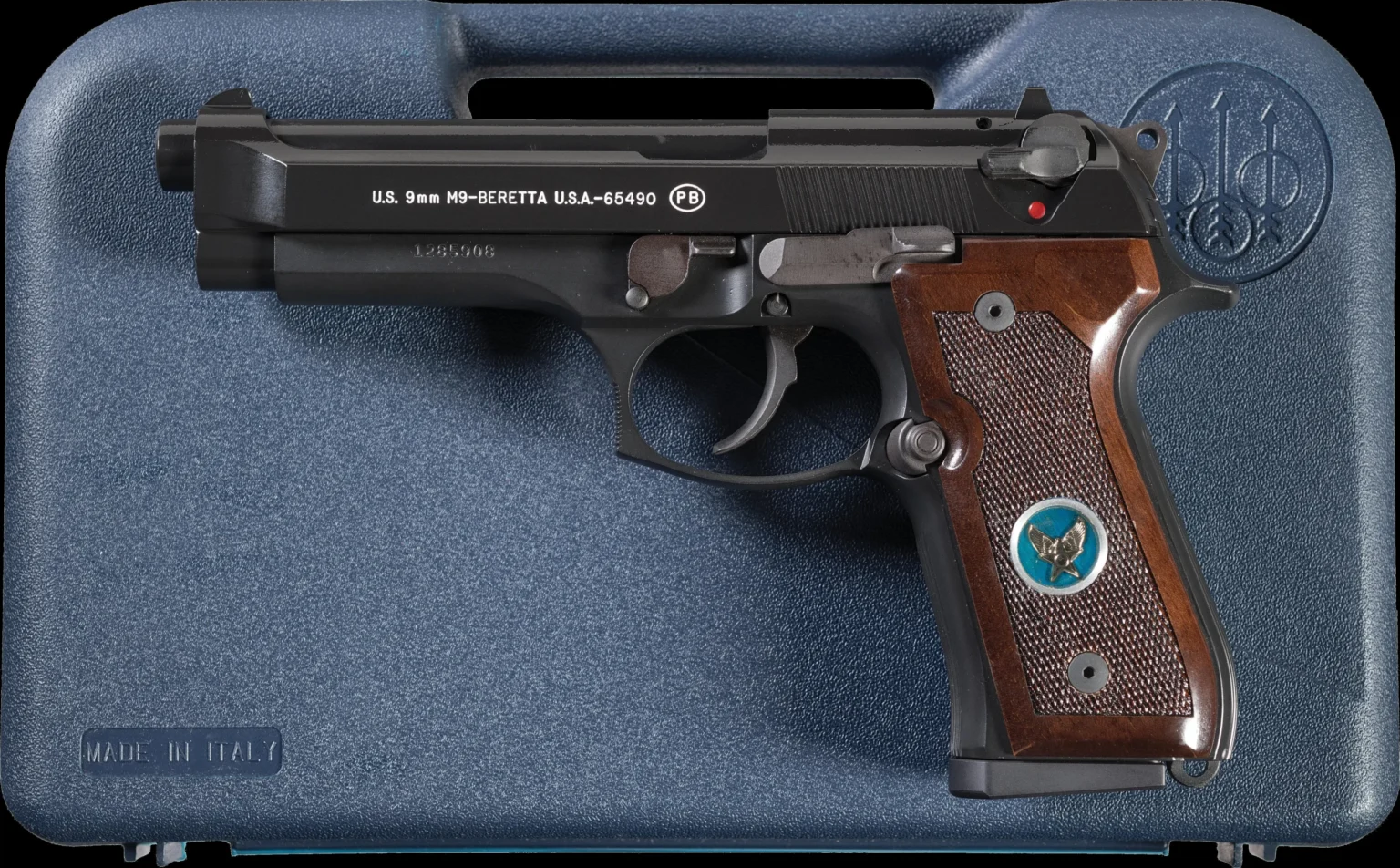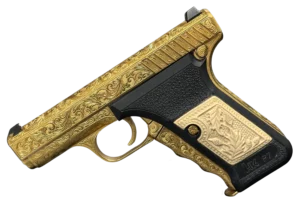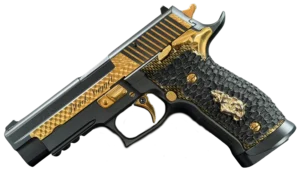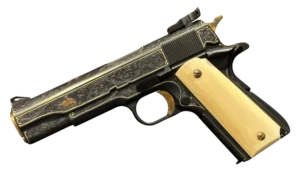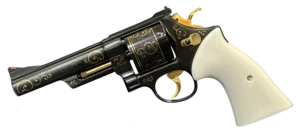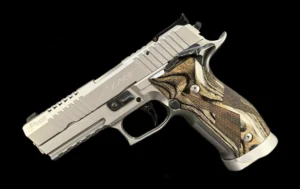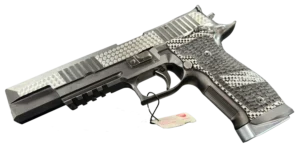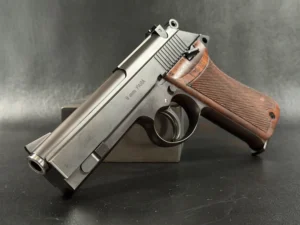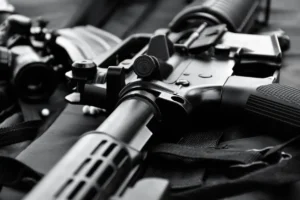Key Takeaways:
- The M9-P isn’t just a firearm — it’s a living slice of military history: It replaced the 1911 after more than 70 years and became the U.S. military’s standard sidearm, serving in countless conflicts and agencies. Owning one isn’t just about specs; it’s about holding a weapon that helped define modern service pistols.
- Despite newer models like the M9A3, the M9-P still holds its own: Sure, the A3 brought some tweaks—rail, threaded barrel, thinner grip—but the M9-P remains rock-solid. It’s accurate, reliable, and still favored by shooters who value proven performance over trendy features.
- Whether you shoot it or shelf it, the M9-P has depth: It’s not just for range days (though it shines there too). It’s a gun with collector value, customization potential, and a story that continues to evolve. For shooters, collectors, and history buffs alike, it checks all the boxes.
Let’s be real for a second—some guns feel right in your hand. They don’t just fire rounds; they carry history, personality, and purpose. The Beretta M9-P is one such gun.
For many collectors (and shooters, too), it’s not just about performance. It’s about the story. And the M9-P? It’s packed with stories—military trials, law enforcement duty, range days, quiet admiration behind a display case. It’s that rare mix of utilitarian toughness and collectible appeal.
So if you’re looking to understand why this Beretta deserves more than just a passing glance, pull up a chair. Let’s talk.
A Military Workhorse with Collector Appeal
The Beretta M9-P traces its lineage back to the mid-80s, when it was adopted as the U.S. military’s standard sidearm. That alone earns it a permanent page in American firearm history. Before the M9, the U.S. armed forces had clung to the 1911 for over 70 years. Replacing that kind of legacy isn’t small potatoes.
Introduced in 1985, the M9-P was essentially a military-stamped version of Beretta’s long-standing 92 series—but with specific tweaks to meet the Pentagon’s demands. Over the decades, it evolved through variants and adaptations, each one reflecting changes in battlefield needs and tech advancements. And for collectors? That means options. Lots of them. From early M9s with phosphate-finished internals to later M9A3 variants with tactical rails and threaded barrels.
It’s the kind of pistol that lets you track the evolution of modern military doctrine… just by lining up a few versions in your safe.
Performance That Earned Its Stripes
Let’s not pretend the M9-P got picked just for its good looks. This thing earned its role the hard way.
It’s chambered in 9mm, runs a 15-round magazine, and features Beretta’s iconic open-slide design. That last part is more than just a visual quirk—it reduces the chance of stovepipes. It aids ejection, which, if you’ve ever dealt with finicky pistols under pressure, you’ll appreciate immediately.
And the chrome-lined barrel? That’s not just a durability boost. It helps with corrosion resistance and contributes to the M9-P’s reputation for consistently tight groups, even after thousands of rounds. Combine that with a full-size frame, and you’ve got a platform that’s not just durable but comfortable.
Then there’s the DA/SA trigger—double-action on the first pull, single-action after that. It gives you a heavy, deliberate pull for the first shot (added safety for carry) and then a crisp, short pull for the follow-ups. That balance between safety and speed is a big part of the pistol’s appeal.
Oh—and you also get second-strike capability. If a round doesn’t go off the first time? Just pull the trigger again—no tap-rack dance required.
Design That Feels Like Home
If you’ve ever picked up a 92-series Beretta, you know what I mean: it just fits. The M9-P is no exception.
There’s a certain elegance to its lines, sure—but this isn’t beauty for beauty’s sake. The ergonomic grip, the intuitive controls, the way the weight sits in your hand—it’s all designed for practical comfort. This is a pistol designed for use, not just admiration.
And yet… It’s hard not to admire it.
Also worth noting are the ambidextrous safety and reversible magazine release. If you’re a lefty (or just like to train weak-hand drills), that’s a big deal. It means you don’t have to fight the gun. It’s already working with you.
Why the M9-P Still Matters (A Lot)
Some people get distracted by the newer, flashier options available. You’ve probably heard them—polymer frames, red-dot ready slides, modular chassis. And that’s fine. The modern pistol market has a wealth of options to offer.
But here’s the thing: the M9-P is still here. It’s still in the armories. Still in holsters. Still on firing lines.
And that’s not just because of nostalgia—it’s because it works. Over three decades of real-world deployment say a lot more than a YouTube review ever could.
It’s also been trusted by more than just the military. The FBI, DEA, and numerous police departments have issued or authorized it. That’s a massive vote of confidence in a sidearm’s performance and durability. If people are betting their lives on a tool, you better believe they’ve done the research.
M9-P vs. M9A3: The “Old Guard” Still Has Teeth
Let’s get into it.
The M9A3 was introduced to modernize the M9 platform slightly. And sure—it brought some solid updates: a thinner grip, a threaded barrel, a removable front sight, a more aggressive texture, and an accessory rail. They tweaked it for modern tactical use. For shooters with small hands or those who want to mount a light or suppressor, this might be a consideration.
But that doesn’t mean the M9-P got left behind. Some would argue that the M9A3’s upgrades are more about personal taste than performance necessity.
The M9-P is still incredibly shootable. Its grip is more traditional (and some find it more comfortable over longer range sessions), the controls are proven, and unless you’re doing night ops with a suppressor, most of the M9A3’s enhancements aren’t deal-breakers.
Put, the M9A3 is a “refined” version. The M9-P is the proven one.
Collectibility: More Than Just Function
There’s something quietly thrilling about owning a service weapon that has stood the test of time. The M9-P was the first new sidearm adopted by the U.S. military in over 70 years—a massive shift away from the .45-caliber 1911.
Collectors know how rare that kind of institutional change is. And when it happens, the gun that causes it becomes iconic by default.
Plus, the M9-P’s run includes some fascinating variations. Early-contract models. Marked units from specific branches or law enforcement agencies. Transition-era builds have mixed features. It’s a rabbit hole, honestly—but in the best way. One of those guns is where the deeper you go, the more there is to uncover.
It’s Not Just a Collector’s Piece
Let’s not lose sight of this: the M9-P isn’t just for your display case.
It’s a very shootable handgun. Whether you’re taking it to the range, entering a local match, or (hopefully not) using it in a defensive situation, it holds its own. The 15-round capacity, the steady recoil impulse, the accuracy out of the box—these aren’t outdated features.
And thanks to the massive popularity of the 92 platform, there’s no shortage of aftermarket support. Want to change the grips? Easy. Upgrade the sights or trigger? Plenty of options. The M9-P can be your project gun or your forever stock shooter.
It flexes both ways.
For the Range. For the Safe. For the Story.
So why pick up an M9-P now?
Maybe you’re a die-hard Beretta fan. Perhaps you’re seeking a sidearm with a proven track record. Or maybe—just maybe—you want a piece of living history that also happens to put holes in paper right where you want them.
Whatever the reason, it’s a smart grab.
Because the M9-P isn’t just a gun, it’s a chapter. Of American military history. Of Beretta’s legacy. Of your collection.
Final Thought (Not Quite a Conclusion)
You don’t have to justify picking up an M9-P. It makes sense on its own. Reliable. Proven. Smooth-shooting. Handsome in that “military-issue-but-somehow-still-slick” way.
And whether it ends up as your bedside gun, your favorite range toy, or the star of your collection—well, that’s up to you.
But it won’t just sit there. It’ll whisper stories. About Marines in the desert. About agents on raids. About the days when 9mm replaced .45 in the service pistol world.
It’s still got plenty to say.
Frequently Asked Questions
The “P” in M9-P typically refers to a variant built to military or police contract specs, often with slight differences in markings or features depending on the issuing agency. That said, it still shares the same DNA as the standard M9—same caliber, same core design. Think of it like a sibling with a slightly different job title.
Absolutely. While it’s not dripping in modern tactical bells and whistles, the M9-P holds up incredibly well. It’s reliable, accurate, and ergonomic—qualities that never go out of style. Newer models might offer minor upgrades, but the M9-P’s performance still exceeds its weight class.
Totally. The M9-P is part of the broader 92 series family, which means there’s a ton of aftermarket support out there—grips, triggers, sights, you name it. Whether you want to customize it or keep it running, you’ve options.
Yes, if you’re comfortable with a full-size pistol. The M9-P is accurate, holds 15 rounds, and has a track record of saving lives in military and law enforcement settings. Just keep in mind—it’s a bit bigger than many modern carry guns, so it’s better suited for home defense or open carry than concealed carry.
History. Plain and simple. The M9-P marked a massive shift in U.S. military small arms, and it was the first standard-issue pistol adopted after the iconic 1911. Add in its use across multiple agencies and decades of service, and you’ve got a piece that tells a real story, not just one that looks good in a case.


